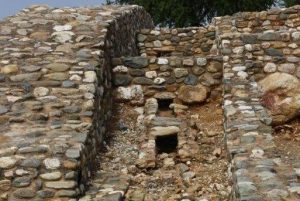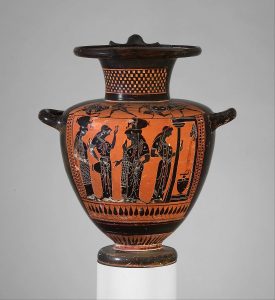Water Supply and Waste Management
Julia Minato
The best evidence for the ancient Greek bathroom is what remains of bathtubs, toilets, and the drainage systems at ancient sites. It is important to remember that not all of the homes were the same and their bathroom spaces also varied. Some houses at Olynthus, for example, have “bathtubs,” but fragments of stand up basins in others show that washing was commonly done standing up.

Some homes had drains that removed waste and other homes had portable toilets. Some cities, like ones found in Crete, had sewage lines that would lead out of the city where the waste would be disposed of. Other cities did not have such infrastructure and so it was up to the members of the household to dispose of the waste. Homes that were small would likely not have a designated space for the bathroom. To maximize the uses of the space they may not have included a bathroom or if they had a small space, they could have used a portable toilet instead, like a chamber pot, that could be used in any space.
When there was a dedicated space for the bathroom not all bathroom spaces looked the same. At Olynthus, remains of bathtubs and terracotta toilet seats have been found in spaces also used for a variety of other activities. During the Hellenistic period, specialized rooms with multiple seat toilets appeared so more people could use the bathroom at the same time and to maximize the capacity of the space. Most public bathrooms in ancient Greece had multiple seats and no privacy and this would be the same in homes as well even though there would not be as many seats in a home that had a built-in toilet. The design of some toilets had a flushing feature that deposited waste under the floor of the bathroom and water would take the waste out of the house through the sewer system. Smaller homes would typically have a clay pot that would be used for waste and be cleaned out outside of the house. There are different bathroom spaces depending on the location of the house and its size, but it is clear that bathrooms were not a necessary feature of houses and that multiple bathroom spaces in one home was not normal.
Segregation and Toilets
Whereas today in North America and other historical periods, like the Antebellum South, bathrooms, whether public or private, can be restricted to particular users, there is no clear evidence that the bathroom space was gendered in ancient Greece or if enslaved people would be prohibited from using the same bathroom space as free individuals. Based on what we know of female virtue, it is likely that women would only be allowed to be with women in the toilet, if the space had more than one seat. The same would go for men.
As discussed above, some toilets had a flushing system that would bring the waste outside of the house and in some cities the waste would be brought outside of the city. Their drains would be cleared manually and after a rainfall. For those families that used clay pots, they would need a supply of water in the home to clean them out.
Some homes had their own wells or cisterns and thus their own water source. The type of water supply was different for each home. Some homes included factories (see chapter 10) and thus needed more water than other homes because they needed the water for their work. In other homes the water was used for everyday tasks such as cooking and cleaning and washing. There is evidence at Olynthus of clay pipes that likely brought supplies of water into homes. Water could also come from communal water fountains. It would be collected and stored in hydrias, a special vessel (shown in the image below), for transporting and storing water within the home. There would be multiple hydrias of water that had different uses in the house (washing, drinking, cleaning), but it is unclear how many times each household was allowed to replenish their supply.

What is known is that fetching the water was a woman’s job and more specifically a job for enslaved women in wealthier households. This can be seen in Attic vase paintings, like the scene on the left, which depict groups of women going to the water fountain to collect water. In some cases it is clear that the women depicted are non-Athenian and enslaved, since they have short hair or are decorated with tatoos. From these pottery examples we can see that this was a task for the women which might seem strange when we know that men were usually the ones who did the work outside of the house. Since water in the house was important for everyday life and women would be working in the house most of the time, fetching the water became a task for women.
Although there is not much known about the bathroom space, it still played a vital role in the daily life of the ancient Greeks. Bathrooms are an important part of any home in North America today and over time the Greeks understood this as well and made an effort to separate and distinguish the space from the other rooms of the house. But we have also seen how a designated bathroom space was not necessary. There may not be much known about the social practices of the bathroom space, but from what we know about how the house was set up and the gendering of space we can infer that the bathroom would follow similar practices.
Bibliography and Further Reading
- Antoniou, P.G. et al. 2016. “Evolution of Toilets Worldwide through the Millennia.” Sustainability 8.8: 779.
- Antoniou, P.G. 2007. “Lavatories in Ancient Greece.” Water Supply 7.1: 155-164.
- Angelakis, A.N. et al. 2020. “Evolution of Urban waste- and storm water management in the region of Crete, Greece: a preliminary assessment”. Water Science and Technology 81.11: 2281-2290.
- Crouch, D.P. 1993. Water Management in Ancient Greek Cities. Oxford: Oxford University Press.

